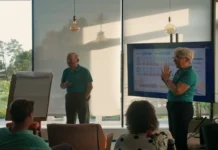Entries were received from almost half of all secondary schools in the Republic of Ireland towards the BT Young Scientist & Technology Exhibition (BTYSTE) 2025, with over 4,000 students from 352 schools across the island showcasing their innovation and ingenuity through 2,069 project entries. Several of these are local and include a variety of interesting project topics.
Tackling a broad range of topics relating to Science, Technology, Engineering, and Mathematics (STEM), the 550 shortlisted projects will get set to represent their schools and local communities at the BTYSTE in January 2025, which as usual, takes place at the RDS, Dublin.
Health has emerged as a key theme, accounting for over one-third (42%) of all project entries across a number of categories with topics covered ranging from the impact of vaping to mental health, to hospital queues. The second key theme (27%), environmental sustainability, included projects on pollution, waste management, renewable energy, biodiversity and conservation.
LOCAL FINALISTS
Scoil Pól in Kilfinane have 2 group (3) entries qualified: ‘City Greens: Growing Food with Hydroponics and Aquaponics for Sustainable Urban Farming’ (Biological & Ecological) and ‘Visualise It! An interactive teaching tool’ (Technology).
Blackwater Community School in Lismore have a single individual entry, ‘Where is the Truth: The Effects of Media Propaganda on Young People’ in the Social & Behavioural Sciences category.
Two group (2) projects from Loreto Secondary School, Fermoy have been accepted – ‘The Hitchhiker’s Guide to the Manosphere – the Effects of Manosphere Content on the Mental Health of Adolescent Boys’ (Social & Behavioural Sciences), along with ‘What is the phycological reasoning behind people not contributing to their recovery from epileptic seizures’ (Health & Wellbeing); while two individual projects have made the cut – ‘The impact of diet interventions on 2km rowing performance’ (Biological & Ecological) and ‘An investigation of the impact of the Covid-19 lockdown on social gatherings of teenagers’ (Social & Behavioural Sciences).
Glanmire Community College’s individual entry ‘Has 40 years of progressive education in society changed the gender stereotypes in the workplace?’ (Social & Behavioural Sciences) qualified.
Colaiste An Phiarsaigh, Glanmire’s Health & Wellbeing project ‘An bhfuil Ozempic sláíntiúl’, Technology project ‘Anailís ar ghrianghrafadóireacht analógach agus digiteach’, along with ‘An Éifeacht Mandela: Conas a oibríonn sé?’ (Social & Behavioural Sciences), all group (2) entries, have made the shortlist.
The individual entry ‘River creature crisis’ for St Colman’s Community College, Midleton in the Biological & Ecological category has qualified as a finalist.
While Midleton College’s group (2) entry ‘Microplastics in the Irish Brown Crab’ in the Biological & Ecological category, along with an individual entry titled ‘An Investigation into the Factors Influencing how People Learn Most Effectively’ in Social & Behavioural Sciences, are qualifiers.
Davis College, Mallow have a number of group (2) entries: ‘AI Trained Camera for Detecting Dogs and other Quadrupedal Animals in Public Places’ (Technology), along with ‘Let’s Get Rolling- Wheelchair Fitbit’ (Health & Wellbeing) and ‘Smart Embedded Clothing for the Visually Impaired’ (Technology).
St Mary’s Secondary School Mallow have several entries making the shortlist, both under the Health & Wellbeing category – ‘Boosting Brainpower: An Investigation into the Effect of ‘Movement Breaks’ on Student Cognition, Well-Being, and Academic Performance’, along with ‘An Investigation into the Role of Noise in Irish Schools: Impacts on Behaviour, Learning, and Emotional Health in Mainstream and SEN Students’.
Under the group (3) projects, ‘An Investigation into using Total Leaf-Area as a predictive tool for determining below-ground biomass at all stages in the growth of selected Root-Crop Plants’ (Biological & Ecological category); ‘An investigation into micro-plastic degradation in aquatic habitats using UV and heat energy, and their potential for reducing potable water contamination’ (Chemical, Physical & Mathematical Sciences) and ‘Development and Evaluation of a Wearable Distress Detection and Response System for Open Water Swimmers’ (Technology) will be appearing at the RDS.
Their Group (2) project ‘Analysing Temporal Variations in Quasar Flux: A Python-Based Approach to Satellite and Observatory Images’ in the Chemical, Physical & Mathematical Sciences category is also a finalist.
DIVERSE RANGE OF PROJECTS
A number of other areas that have become popular in this year’s entries for the first time, perhaps demonstrating the strong influence of Ireland’s socioeconomic agenda and cultural and social dynamics on students, include projects on the new deposit return scheme, electoral voting and inclusivity in education.
STEM-focused subjects relating to biology (9%) and technology (8%) also account for a large proportion of entries. Other popular themes emerging in the areas of technology include artificial intelligence and machine learning. Chemistry, physics and mathematics also featured heavily among entries.
Schools that entered were only notified of the results of the shortlisted projects on Monday (21st).
With over 200 prizes and a prize fund of well over €50,000 to be won across all five categories and age groups, students’ hopes will be high. The overall BT Young Scientist & Technologist(s) of the Year Award, worth €7,500, will see the winners go on to represent Ireland at the prestigious European Union Contest for Young Scientists (EUCYS), which will take place in Latvia.









